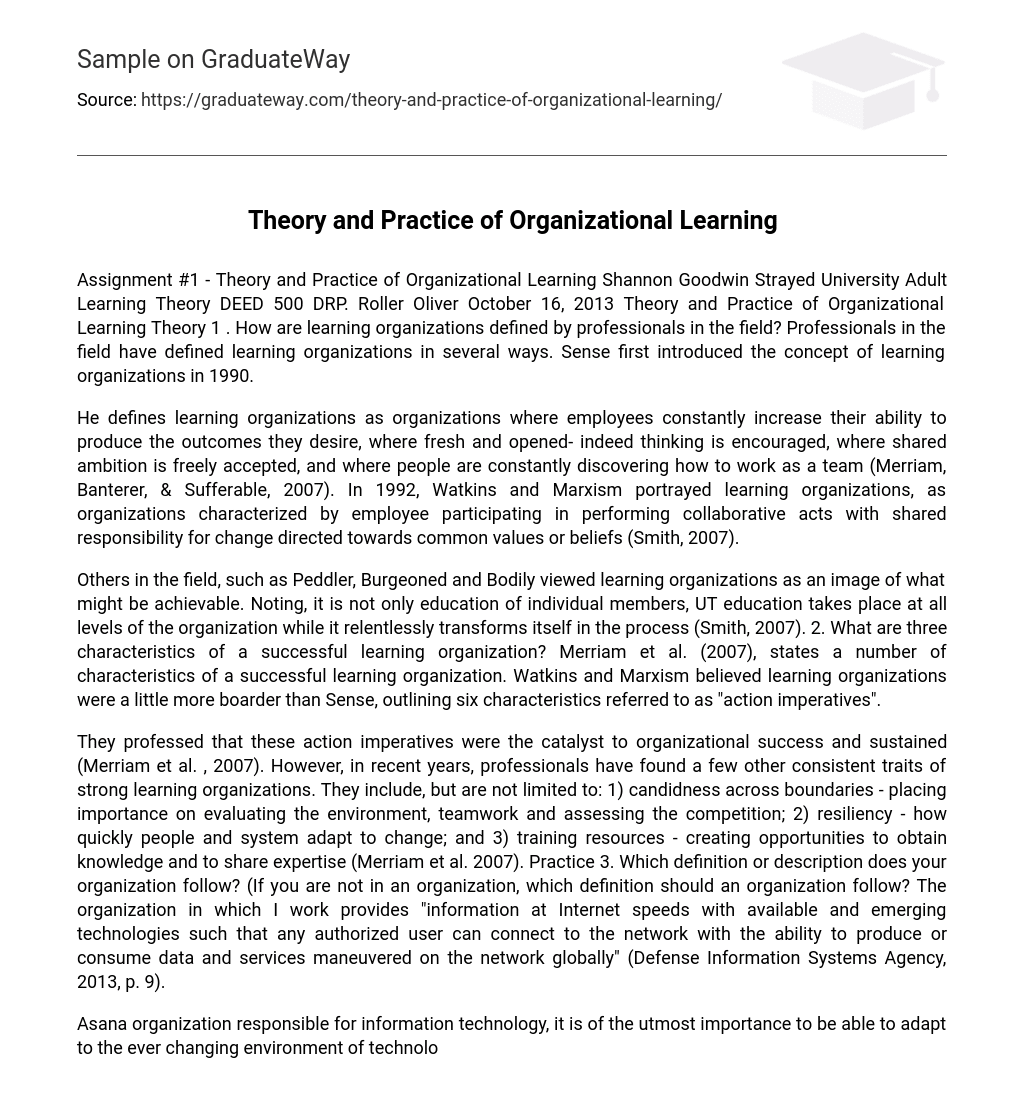How are learning organizations defined by professionals in the field? Professionals in the field have defined learning organizations in several ways. Sense first introduced the concept of learning organizations in 1990. He defines learning organizations as organizations where employees constantly increase their ability to produce the outcomes they desire, where fresh and opened- indeed thinking is encouraged, where shared ambition is freely accepted, and where people are constantly discovering how to work as a team (Merriam, Banterer, & Sufferable, 2007).
In 1992, Watkins and Marxism portrayed learning organizations, as organizations characterized by employee participating in performing collaborative acts with shared responsibility for change directed towards common values or beliefs (Smith, 2007). Others in the field, such as Peddler, Burgeoned and Bodily viewed learning organizations as an image of what might be achievable. Noting, it is not only education of individual members, UT education takes place at all levels of the organization while it relentlessly transforms itself in the process (Smith, 2007).
What are three characteristics of a successful learning organization? Merriam et al. (2007), states a number of characteristics of a successful learning organization. Watkins and Marxism believed learning organizations were a little more boarder than Sense, outlining six characteristics referred to as “action imperatives”.
They professed that these action imperatives were the catalyst to organizational success and sustained (Merriam et al. , 2007). However, in recent years, professionals have found a few other consistent traits of strong learning organizations. They include, but are not limited to: 1) candidness across boundaries – placing importance on evaluating the environment, teamwork and assessing the competition; 2) resiliency – how quickly people and system adapt to change; and 3) training resources – creating opportunities to obtain knowledge and to share expertise (Merriam et al. 2007).
Which definition or description does your organization follow? (If you are not in an organization, which definition should an organization follow? The organization in which I work provides “information at Internet speeds with available and emerging technologies such that any authorized user can connect to the network with the ability to produce or consume data and services maneuvered on the network globally” (Defense Information Systems Agency, 2013, p. 9).
Asana organization responsible for information technology, it is of the utmost importance to be able to adapt to the ever changing environment of technology and globalization. Thus, my organization follows the definition of a learning organization as described by Sense. Meaning, my organization encourages its employees to pursue learning opportunities at all level, it fosters an environment of honesty, candidness and opened-mindedness to cultivate innovation and creativity; and places, a strong emphasis on a team building approaches to achieve its objectives.
What two or three organizational learning practices does your organization follow? Three of the primary learning practices my organization follows are systemic thinking, shared vision, and team learning. According to Malory (1996), these three practices fall within the generative learning theory. Generative learning, also known as “double-loop” learning, is all about viewing the world from a new and innovative perspective. It not only focuses on the achievement of goals, but how to capitalize from mistakes made during the process (Malta, 1996).
My organization encourages its employees to view things in wholes versus in parts. It thrives on the team building approach and problem solving. Furthermore, emphasis is placed on training opportunities for all – from the grassroots worker, to the mid-level and executive-level manager. The objective of such training is to ensure employees attain knowledge that can be integrated into organizational processes across the full spectrum of responsibilities.
Do you consider the learning practices of your organization to be effective or ineffective – why or why not? If you are not in an organization, what two or three best practices that an organization should follow? I believe the learning practices of my organization are effective. Employing learning practices that promote systemic thinking, encourage teamwork, and foster opened-mindedness are all effective methods. However, my organization goes beyond these approaches; y providing avenues for continuous training and rewarding creativity. This double-loop learning approach is essential in overcoming challenges and achieving objectives.





